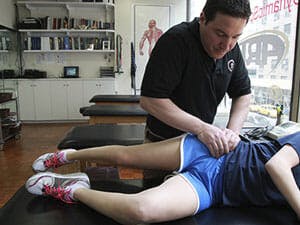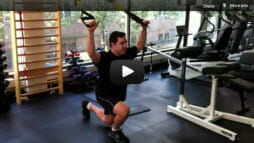PRE OPERATIVE HIP PROGRAM
This program is designed for people who have hip joint pain due to degenerative changes, impingement (FAI), and labral tears. It is meant to provide guidelines for this population to build strength, flexibility, and endurance prior to any surgical procedure as well as those who have decided not to have surgery. All exercises are shown for the involved hip. If time permits it is always beneficial to work the other side as well.
If time permits it is always beneficial to work the other side as well.
WARM UP/ CARDIONon Impact exercise such as stationary cycling and elliptical machines are great ways to keep the joint moving and maintain cardiovascular health. It is important to keep all exercise pain free and only work in pain free range of motion. While cycling keep the seat high to avoid pinching at the hip. High impact activities such as running and jumping should be avoided to prevent irritating the joint surfaces. Swimming is also a good non impact activity but, be careful with strokes like the breast stroke where the kick may cause pain in the hip joint.
FLEXIBILITYFoam rolling is a great way to decrease pain and improve flexibility at the hip joint. The following pictures illustrate the proper technique for using the foam roller. For each muscle group find the most painful spot in that muscle and hold for 30 seconds. Repeat 3 x.
STRETCHINGBelow are a group of stretches that address the muscles of the hip joint. There are multiple versions for certain muscle groups so use the one that is most comfortable for you or feel free to use them all. Remember, during these stretches no sharp pain in the joint should be felt. You should move into a position where there is a mild pulling in the muscle to be stretched and hold this position for 20¥30 seconds. Repeat 3x.
HIP STRENGTHENINGART has been developed, refined, and patented by P. Michael Leahy, DC, CCSP. Dr. Leahy noticed that his patients' symptoms seemed to be related to changes in their soft tissue that could be felt by hand. By observing how muscles, fascia, tendons, ligaments and nerves responded to different types of work, Dr. Leahy was able to consistently resolve over 90% of his patients' problems. He now teaches and certifies health care providers all over the world to use ART.
POST-OPERATIVE REHAB
This program was developed for active individuals who intend to return to athletics and athletic style training following a hip surgery. It is intended to bridge a gap between traditional rehabilitation and return to sport. Once you have achieved adequate range of motion, flexibility, and muscle strength (usually 10-12 weeks following surgery) the next step is using what you have achieved in physical therapy and start moving well enough to return to sports.
The TRX suspension trainer is a great tool to help you reach your goals and return to athletics.
- It uses your own body weight as resistance.
- It can be used to unload your body to decrease joint stress.
- It's portable and can be used anywhere.
- It engages important core musculature that is necessary to move properly.
5 Post Operative Tips
- Ice as often as possible to reduce inflammation.
- Listen to your body. If something hurts it is best to avoid it. You may feel tired in the weeks following surgery. Don't try to push through, give your body the rest it needs.
- Follow Doctors Instructions regarding precautions, weight bearing, lifting, and return to activities.
- Don't compare yourself to others who had similar procedures. Remember everyone heals at a different pace and you need this time to let your hip recover.
- Avoid pivoting on involved leg and avoid sitting in low chairs or couches.
ART FOR HIP PAIN

The hip joint is one of the most complex joints in our body. It consists of a ball and socket joint that is capable of a wide range of motion.
In addition to this large range of motion there is also a huge amount of force that gets transferred through the hip joint because it attaches the lower extremity to the trunk. Due to this high amount of force, combined with the wide range of motion, the hip must rely on a complex system of muscles to control and protect the area.
Through a variety of causes such as athletic activities, prolonged sitting, repetitive movements, excessive use, or lack of physical activities, one or more of the muscles of the hip region can become tight or weak creating a muscle imbalance. With pathologies like labral tears, osteoarthritis, and FAI, there is limited range of motion which cause structures around the hip to become short or tight.
When a muscle imbalance occurs, the surrounding muscles are put under more stress and end up working harder to compensate for the tight or weak muscle. Over time, this stress can develop into what is known as "micro-trauma". Simply stated, micro-trauma is small scale damage that occurs in muscles, tendons, ligaments, and joint capsules in response to small levels of strain.
The body will respond to this micro-trauma by laying down scar tissue to repair the injured tissue. Following any surgical intervention of the hip joint, the body will also lay down scar tissue that will lead to restrictions in the tissue. It is these restrictions or adhesions that lead to pain, tightness, stiffness, restricted joint motion, and diminished blood flow. If these restrictions go untreated, you are likely to experience more pain and enter into what is known as the "repetitive strain injury cycle".
The repetitive strain injury cycle occurs when continued micro-trauma leads to further adhesion formation which, in turn, will lead to more stress and further micro-trauma. As the cycle builds, your symptoms become more noticeable and often times a simple activity may cause a sudden pain.
Active Release Technique [ART] is a new, highly successful, hands-on treatment method to address problems in the soft tissues of the body including the muscles, ligaments, fascia, and nerves. By locating and treating soft tissue restrictions, it allows the practitioner to: 1) break up restrictive adhesions, 2) reinstate normal tissue flexibility and movement, and 3) more completely restore flexibility, balance, and stability to the injured area and the entire kinetic chain.
The practitioner will first shorten the structure being treated and then apply a very specific pressure with their hands as you actively stretch and lengthen the tissue. As the tissue lengthens, the therapist will assess the texture and tension of the tissue to determine if it is healthy or there is a scar tissue adhesion present. When scar tissue is felt, the amount and direction of tension can be modified to treat the problematic area.
Typically, the majority of hip injuries respond very well to ART treatment, especially when combined with a specific stretching and strengthening program. We usually find a significant improvement in just 4-6 treatment sessions. ART practitioners commonly work with elite athletes and are on site at all the Ironman Triathlon events. It has also been very beneficial in treatment of soft tissue hip pathologies in patients before or following any surgical procedure.
If you are experiencing pain and/or limitations in or around your hip joint, ART may be the treatment for you. Please contact an ART provider for more details. For more information, please go to www.ActiveRelease.com.
Peter Schultz DPT, OCS, CSCS is a Doctor of Physical Therapy practicing since 1999. He is owner and therapist at Dynamic Sports Physical Therapy in New York City. Peter’s specialty is orthopedic and sports injuries with a particular interest in hip rehabilitation. Having had two hip surgeries himself, Peter brings a unique approach to his clients.


